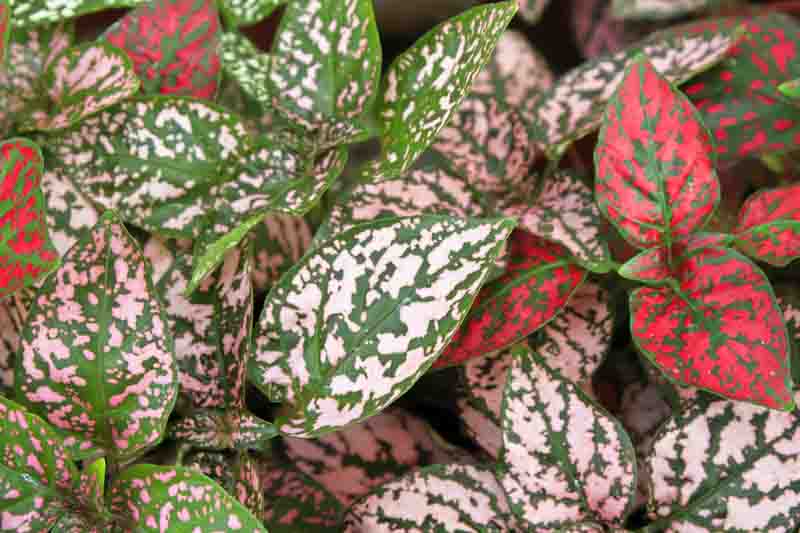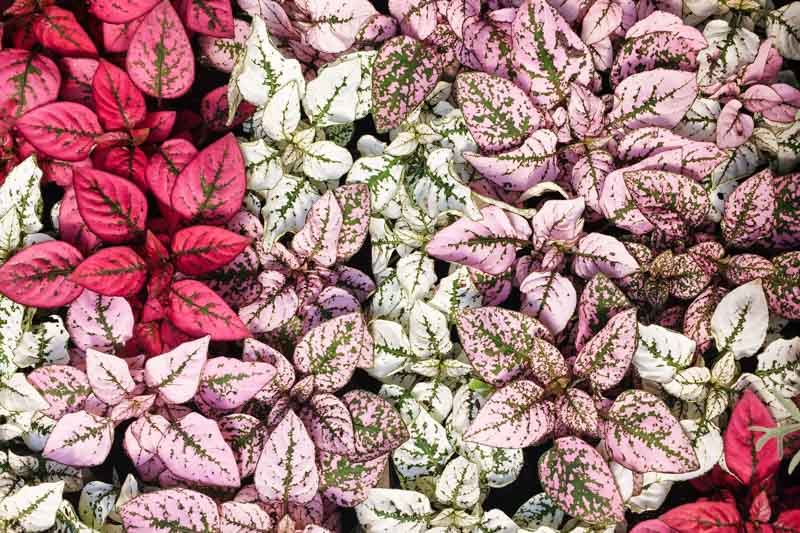Polka Dot Plant, Freckle Face, Measles Plant, Pink Dot, Flamingo Plant
Hypoestes phyllostachya, commonly known as the Polka Dot Plant, is a species of flowering plant in the Acanthaceae family. It is native to Madagascar and is popular as a houseplant or outdoor ornamental plant in tropical and subtropical regions due to its striking foliage and easy cultivation.
Description: The Polka Dot Plant is known for its oval-shaped leaves, which are green with contrasting pink, red, or white spots. The vibrant colors and patterns make it a standout plant in any setting.
Growth habit: Hypoestes phyllostachya has a bushy growth habit and tends to branch out as it grows. It can be pruned to maintain a desired shape and size.
Size: The plant typically grows to a height of 1 to 3 feet (30 to 90 cm) and spreads out to around 1 to 2 feet (30 to 60 cm) in width.
Flowers: The Polka Dot Plant produces small, tubular flowers that are generally lilac or pale purple in color. The flowers are not as showy as the foliage and may be less noticeable.
Blooming season: The plant typically blooms in the late spring to summer months, although it may bloom sporadically throughout the year when grown indoors.
Hardiness: Hypoestes phyllostachya is a tender evergreen sub-shrub, meaning it can only survive outdoors in USDA hardiness zones 10 and 11. In colder climates, it is often grown as an annual or houseplant.
Uses: The Polka Dot Plant is popular as an indoor plant, in container gardens, or as a bedding plant in outdoor landscapes. It is often used as an accent plant to add color and visual interest to gardens, borders, and mixed plantings.
Award: Recipient of the prestigious Award of Garden Merit of the Royal Horticultural Society.
Toxicity: The Polka Dot Plant is considered non-toxic to humans and pets, although ingestion of large quantities may cause mild gastrointestinal discomfort.

Growing a Polka Dot Plant can offer several benefits and be an excellent addition to your home or garden for various reasons:
Unique and attractive foliage: The Polka Dot Plant is known for its striking foliage with contrasting spots. This unique feature can brighten up any indoor or outdoor space and add a touch of whimsy to your plant collection.
Easy to grow and maintain: Polka Dot Plants are relatively low-maintenance and can be easily grown both indoors and outdoors in suitable climates. They adapt well to a range of light conditions, making them an excellent choice for beginners or those with limited gardening experience.
Versatility: The Polka Dot Plant is well-suited for a variety of settings, such as container gardens, borders, mixed plantings, or as an accent plant in a larger landscape design. They can also thrive indoors as houseplants, making them a flexible addition to your plant collection.
Air purification: Like many houseplants, Polka Dot Plants can help improve indoor air quality by absorbing pollutants and releasing oxygen, contributing to a healthier living environment.
Non-toxic to pets and humans: Polka Dot Plants are considered non-toxic, making them a safer choice for households with pets or small children who may be tempted to nibble on the leaves.
Opportunities for propagation: Polka Dot Plants can be easily propagated through stem cuttings, allowing you to expand your collection or share plants with friends and family.

Indoors: Polka Dot Plants can be planted indoors at any time of the year as long as they are provided with suitable growing conditions.
Outdoors: If you live in a region with suitable climate conditions (USDA hardiness zones 10 and 11), you can plant Polka Dot Plants outdoors after the last frost in spring. In colder climates, it’s best to grow them as annuals or container plants that can be brought indoors during winter.
Light: Polka Dot Plants prefer bright, indirect light. Indoors, place them near a well-lit window with filtered sunlight. Outdoors, plant them in a location with partial shade to protect them from intense direct sunlight, which can cause leaf scorch.
Soil: Plant Polka Dot Plants in well-draining, fertile, and slightly acidic soil with a pH between 6.0 and 6.5. They do not tolerate waterlogged conditions, so ensure proper drainage.
Space: When planting outdoors, space the plants about 12 to 18 inches (30 to 45 cm) apart to allow for proper air circulation and growth.
Prepare the soil: Amend the soil with organic matter like compost or well-rotted manure to improve drainage and fertility.
Planting: For indoor plants, choose a pot with drainage holes and fill it with a high-quality, well-draining potting mix. Plant the polka dot plant at the same depth it was in its original container. For outdoor plants, dig a hole slightly larger than the root ball and gently place the plant inside. Backfill the hole with soil and press gently around the base of the plant. Water the plant.
Caring for Polka Dot Plants involves providing them with the right growing conditions and regular maintenance. Here are some tips for keeping your Polka Dot Plant healthy and vibrant:
Watering: Keep the soil consistently moist but not waterlogged. Water the plant when the top inch of soil feels dry to the touch. Be sure to use well-draining soil to prevent root rot.
Humidity: Polka Dot Plants prefer a humid environment. To maintain humidity, mist the plant with water regularly or place it on a tray filled with water and pebbles. Grouping plants together or using a humidifier can also help increase humidity levels.
Temperature: Maintain a temperature range of 65-75°F (18-24°C) for optimal growth. Avoid placing the plant near drafty windows or heating vents, as temperature fluctuations can stress the plant.
Fertilizing: Apply a balanced, water-soluble fertilizer every 4-6 weeks during the growing season (spring through fall). Reduce or eliminate fertilizing during the winter months when the plant’s growth slows down.
Pruning: Polka dot plants can become leggy over time. Regularly pinch back the tips of the plant to encourage bushier growth. If the plant becomes too leggy, you can cut it back to about half its height to stimulate new growth.
Propagation: Polka dot plants can be propagated through stem cuttings. Take a 4-6 inch (10-15 cm) cutting with a few leaves from a healthy plant, remove the lower leaves, and dip the cut end in rooting hormone (optional). Place the cutting in moistened potting mix or water until roots develop. Once roots are established, transfer the cutting to a pot with well-draining soil.
Pest control: Keep an eye out for common pests like aphids, spider mites, or whiteflies. Use insecticidal soap or neem oil to control these pests as needed. The plant is also susceptible to powdery mildew and root rot.
| Hardiness |
10 - 11 |
|---|---|
| Heat Zones |
9 - 11 |
| Climate Zones | 23, 24, H1, H2 |
| Plant Type | Houseplants, Annuals, Shrubs |
| Plant Family | Acanthaceae |
| Exposure | Partial Sun |
| Season of Interest |
Spring (Early, Mid, Late) Summer (Early, Mid, Late) Fall Winter |
| Height |
1' - 3' (30cm - 90cm) |
| Spread |
1' - 2' (30cm - 60cm) |
| Spacing |
12" - 18" (30cm - 50cm) |
| Maintenance | Low |
| Water Needs | Average |
| Soil Type | Sand |
| Soil pH | Acid, Neutral |
| Soil Drainage | Well-Drained |
| Characteristics | Plant of Merit, Showy, Evergreen |
| Garden Uses | Beds And Borders, Patio And Containers |
| Garden Styles | Mediterranean Garden, City and Courtyard, Informal and Cottage |
Silviopl/Shutterstock
| Hardiness |
10 - 11 |
|---|---|
| Heat Zones |
9 - 11 |
| Climate Zones | 23, 24, H1, H2 |
| Plant Type | Houseplants, Annuals, Shrubs |
| Plant Family | Acanthaceae |
| Exposure | Partial Sun |
| Season of Interest |
Spring (Early, Mid, Late) Summer (Early, Mid, Late) Fall Winter |
| Height |
1' - 3' (30cm - 90cm) |
| Spread |
1' - 2' (30cm - 60cm) |
| Spacing |
12" - 18" (30cm - 50cm) |
| Maintenance | Low |
| Water Needs | Average |
| Soil Type | Sand |
| Soil pH | Acid, Neutral |
| Soil Drainage | Well-Drained |
| Characteristics | Plant of Merit, Showy, Evergreen |
| Garden Uses | Beds And Borders, Patio And Containers |
| Garden Styles | Mediterranean Garden, City and Courtyard, Informal and Cottage |
How many Hypoestes phyllostachya (Polka Dot Plant) do I need for my garden?
| Plant | Quantity | |
|---|---|---|
| Hypoestes phyllostachya (Polka Dot Plant) | N/A | Buy Plants |
Create a membership account to save your garden designs and to view them on any device.
Becoming a contributing member of Gardenia is easy and can be done in just a few minutes. If you provide us with your name, email address and the payment of a modest $25 annual membership fee, you will become a full member, enabling you to design and save up to 25 of your garden design ideas.
Join now and start creating your dream garden!
Create a membership account to save your garden designs and to view them on any device.
Becoming a contributing member of Gardenia is easy and can be done in just a few minutes. If you provide us with your name, email address and the payment of a modest $25 annual membership fee, you will become a full member, enabling you to design and save up to 25 of your garden design ideas.
Join now and start creating your dream garden!